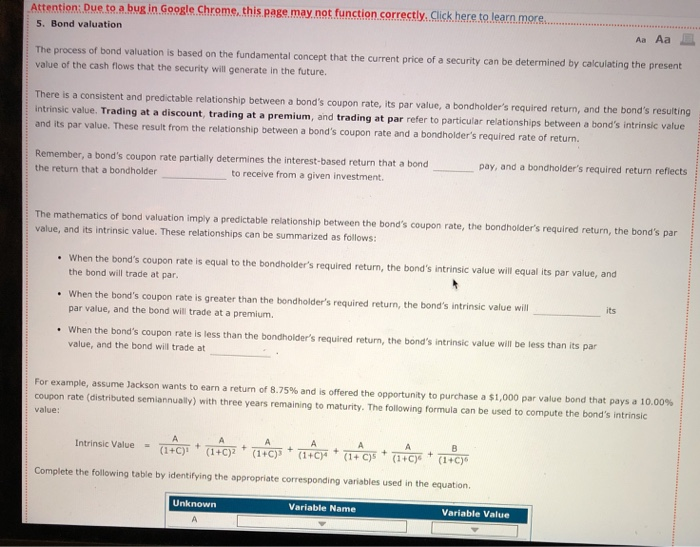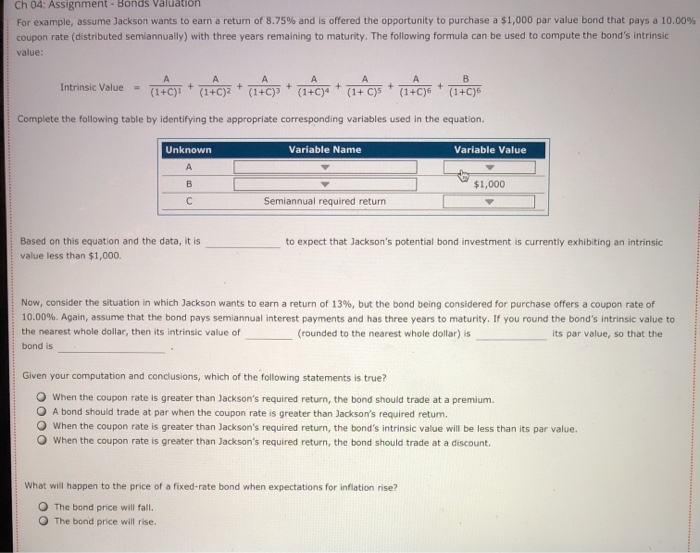Attention: Due to a bug in Google Chrome, this page may not function correctly. Click here to learn more. 5. Bond valuation Aa Aa The process of bond valuation is based on the fundamental concept that the current price of a security can be determined by calculating the present value of the cash flows that the security will generate in the future. There is a consistent and predictable relationship between a bond's coupon rate, its par value, a bondholder's required return, and the bond's resulting intrinsic value. Trading at a discount, trading at a premium, and trading at par refer to particular relationships between a bond's intrinsic value and its par value. These result from the relationship between a bond's coupon rate and a bondholder's required rate of return. Remember, a bond's coupon rate partially determines the interest-based return that a bond the return that a bondholder to receive from a given investment. pay, and a bondholder's required return reflects The mathematics of bond valuation imply a predictable relationship between the bond's coupon rate, the bondholder's required return, the bond's par value, and its intrinsic value. These relationships can be summarized as follows: When the bond's coupon rate is equal to the bondholder's required return, the bond's intrinsic value will equal its par value, and the bond will trade at par. When the bond's coupon rate is greater than the bondholder's required return, the bond's intrinsic value will par value, and the bond will trade at a premium. . When the bond's coupon rate is less than the bondholder's required return, the bond's intrinsic value will be less than its par value, and the bond will trade at its For example, assume Jackson wants to earn a return of 8.75% and is offered the opportunity to purchase a $1,000 par value bond that pays a 10.00% coupon rate (distributed semiannually) with three years remaining to maturity. The following formula can be used to compute the bond's intrinsic value: Intrinsic Value (146) + (14C)2 + (146) + + (1+C) + B (1+ C)S AC+ (1+0) Complete the following table by identifying the appropriate corresponding variables used in the equation Unknown Variable Name Variable Value Ch 04: Assignment - Bonds Valuation For example, assume Jackson wants to earn a return of 8.75% and is offered the opportunity to purchase a $1,000 par value bond that pays a 10.00% coupon rate (distributed semiannually) with three years remaining to maturity. The following formula can be used to compute the bond's intrinsic value: A Intrinsic Value + (1 #CHE + + + (1+ A (1+ C) + (1+C)3 + (1+C)4 A (1+C) B (1+0) Complete the following table by identifying the appropriate corresponding variables used in the equation. Unknown Variable Name Variable Value A B $1,000 Semiannual required retum Based on this equation and the data, it is value less than $1,000 to expect that Jackson's potential bond investment is currently exhibiting an intrinsic Now, consider the situation in which Jackson wants to earn a return of 13%, but the bond being considered for purchase offers a coupon rate of 10.00%. Again, assume that the bond pays semiannual interest payments and has three years to maturity. If you round the bond's intrinsic value to the nearest whole dollar, then its intrinsic value of (rounded to the nearest whole dollar) is its par value, so that the bond is Given your computation and conclusions, which of the following statements is true? When the coupon rate is greater than Jackson's required return, the bond should trade a premium A bond should trade at par when the coupon rate is greater than Jackson's required retum. When the coupon rate is greater than Jackson's required return, the bond's intrinsic value will be less than its par value. When the coupon rate is greater than Jackson's required return, the bond should trade at a discount. What will happen to the price of a fixed-rate bond when expectations for inflation rise? O The bond price will fall. The bond price will rise. 0 0








